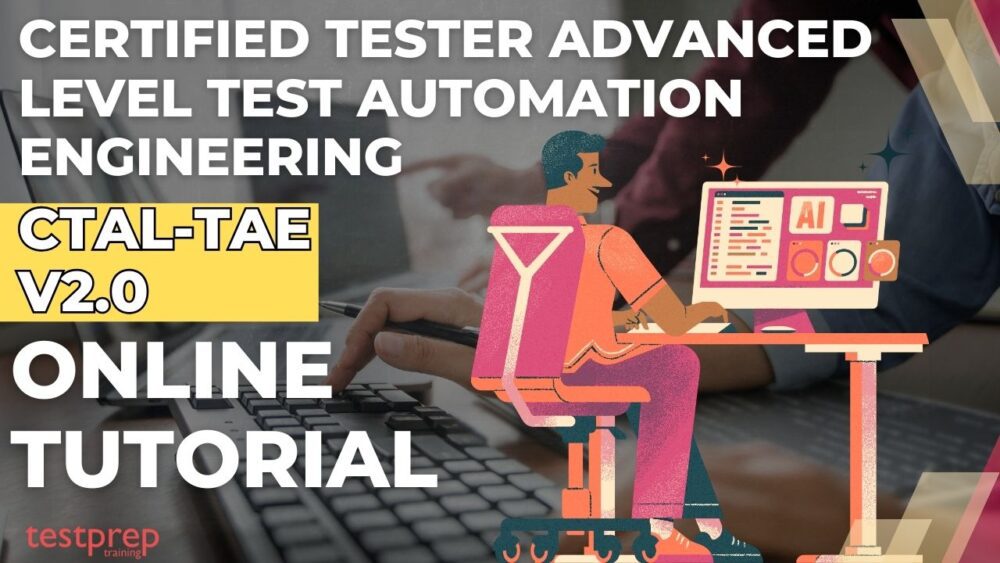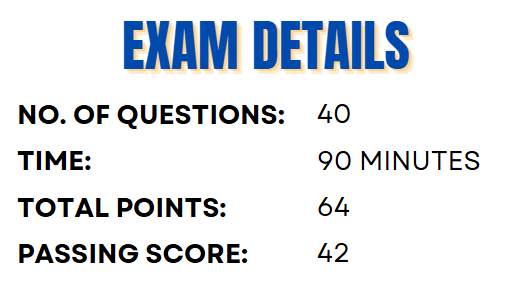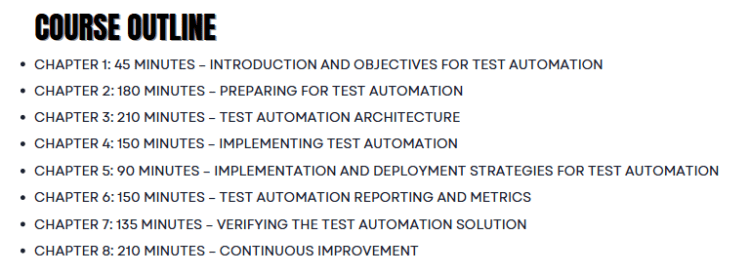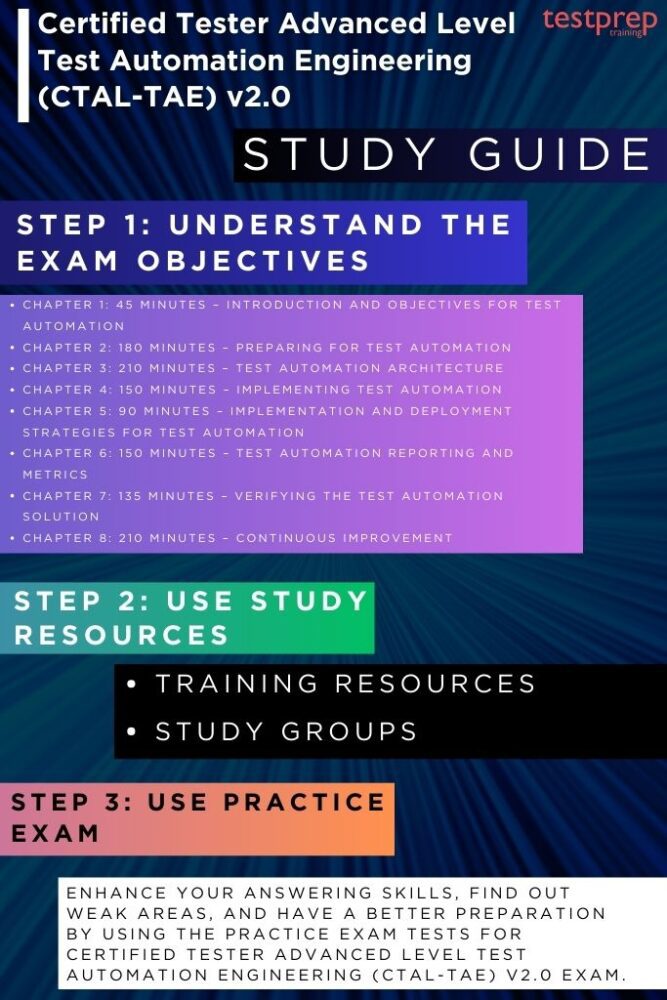Certified Tester Advanced Level Test Automation Engineering (CTAL-TAE) v2.0

The Certified Tester Advanced Level Test Automation Engineering (CTAL-TAE) certification is designed for professionals engaged in software testing and automation. It suits roles like testers, test analysts, automation engineers, test consultants, architects, managers, and developers. This certification also benefits individuals seeking foundational knowledge in test automation, including project managers, quality managers, software development managers, business analysts, IT directors, and management consultants.
Target Audience
The Test Automation Engineering syllabus is for test engineers aiming to establish or enhance test automation processes. It outlines effective practices and techniques to create a sustainable solution. While it references models and guidelines relevant to test automation—such as standards for software development lifecycles, programming practices, and formatting—it does not cover software engineering fundamentals. Test automation engineers, however, should have software engineering knowledge and experience.
In addition, familiarity with industry standards for programming and documentation is crucial for test automation engineers. Applying these standards can improve the maintainability, reliability, and security of automation solutions, as they are often rooted in quality-focused principles.
Recommended Knowledge
To qualify for the Test Automation Engineering exam, candidates should ideally have an interest in software testing and automation. It is also highly recommended that they:
- Have some experience in software development or testing, ideally with at least six months as a software test engineer or software developer.
- Complete a training course accredited to ISTQB standards by an approved provider.
Business Outcomes
Candidates who pass the exam should be able to achieve the following objectives:
- Explain the role and value of test automation.
- Understand how test automation aligns with the software development lifecycle.
- Set up the infrastructure required to support test automation.
- Evaluate and choose appropriate tools and strategies for test automation.
- Apply design principles to create modular and scalable test automation solutions.
- Plan and pilot test automation deployment within the development lifecycle.
- Develop and implement new or updated test automation solutions to address technical requirements.
- Define the scope and maintenance approach for test automation and testware.
- Integrate automated tests into CI/CD pipelines.
- Collect, analyze, and report test automation data to keep stakeholders informed.
- Verify the functionality of the test automation infrastructure.
- Identify opportunities for ongoing improvement in test automation.
Exam Details

The Certified Tester Advanced Level Test Automation Engineering (CTAL-TAE) v2.0 exam consists of 40 questions, totaling 64 points. To pass, candidates need a minimum score of 42 points. The exam duration is 90 minutes, with an additional 25% time allowance for non-native language speakers.
Course Outline
The Test Automation Engineering Certificate exam follows this comprehensive syllabus, where answering questions may require knowledge from multiple sections. It ensures globally consistent training and exam standards by including:
- Broad instructional objectives outlining the purpose of the Test Automation Engineering Specialist role.
- A glossary of essential terms that candidates need to know.
- Learning objectives for each topic, detailing the expected cognitive outcomes.
- Explanations of fundamental concepts, with references to recognized literature and standards.
The syllabus comprises eight chapters with examinable content, each with a designated time allocation. Although timing is only indicated at the chapter level, accredited courses must provide a minimum of 21 instructional hours, distributed across these chapters.

1. Introduction and Objectives for Test Automation – 45 minutes (K-2)
1.1 Purpose of Test Automation
TAE-1.1.1 (K2) Explain the advantages and disadvantages of test automation
1.2 Test Automation in the Software Development Lifecycle
TAE-1.2.1 (K2) Explain how test automation is applied across different software development lifecycle models
TAE-1.2.2 (K2) Select suitable test automation tools for a given system under test
2. Preparing for Test Automation – 180 minutes (K4)
2.1 Understand the Configuration of an Infrastructure to Enable Test Automation
TAE-2.1.1 (K2) Describe the configuration needs of an infrastructure that enable implementation of test automation
TAE-2.1.2 (K2) Explain how test automation is leveraged within different environments
2.2 Evaluation Process for Selecting the Right Tools and Strategies
TAE-2.2.1 (K4) Analyze a system under test to determine the appropriate test automation solution
TAE-2.2.2 (K4) Illustrate the technical findings of a tool evaluation
3. Test Automation Architecture – 210 minutes (K3)
3.1 Design Concepts Leveraged in Test Automation
TAE-3.1.1 (K2) Explain the major capabilities in a test automation architecture
TAE-3.1.2 (K2) Explain how to design a test automation solution
TAE-3.1.3 (K3) Apply layering of test automation frameworks
TAE-3.1.4 (K3) Apply different approaches for automating test cases
TAE-3.1.5 (K3) Apply design principles and design patterns in test automation
4. Implementing Test Automation – 150 minutes (K4)
4.1 Test Automation Development
TAE-4.1.1 (K3) Apply guidelines that support effective test automation pilot and deployment activities
4.2 Risks Associated with Test Automation Development
TAE-4.2.1 (K4) Analyze deployment risks and plan mitigation strategies for test automation
4.3 Test Automation Solution Maintainability
TAE-4.3.1 (K2) Explain which factors support and affect test automation solution maintainability

5. Implementation and Deployment Strategies for Test Automation – 90 minutes (K3)
5.1 Integration to CI/CD Pipelines
TAE-5.1.1 (K3) Apply test automation at different test levels within pipelines
TAE-5.1.2 (K2) Explain configuration management for testware
TAE-5.1.3 (K2) Explain test automation dependencies for an API infrastructure
6. Test Automation Reporting and Metrics – 150 minutes (K4)
6.1 Collection, Analysis and Reporting of Test Automation Data
TAE-6.1.1 (K3) Apply data collection methods from the test automation solution and the system under test
TAE-6.1.2 (K4) Analyze data from the test automation solution and the system under test to better understand results
TAE-6.1.3 (K2) Explain how a test progress report is constructed and published
7. Verifying the Test Automation Solution – 135 minutes (K3)
7.1 Verification of the Test Automation Infrastructure
TAE-7.1.1 (K3) Plan to verify the test automation environment including test tool setup
TAE-7.1.2 (K2) Explain the correct behavior for a given automated test script and/or test suite
TAE-7.1.3 (K2) Identify where test automation produces unexpected results
TAE-7.1.4 (K2) Explain how static analysis can aid test automation code quality
8. Continuous Improvement – 210 minutes (K4)
8.1 Continuous Improvement Opportunities for Test Automation
TAE-8.1.1 (K3) Discover opportunities for improving test cases through data collection and analysis
TAE-8.1.2 (K4) Analyze the technical aspects of a deployed test automation solution and provide recommendations for improvement
TAE-8.1.3 (K3) Restructure the automated testware to align with SUT updates
TAE-8.1.4 (K2) Summarize opportunities for use of test automation tools
Certified Tester Advanced Level Test Automation Engineering (CTAL-TAE) v2.0: FAQS
Certified Tester Advanced Level Test Automation Engineering (CTAL-TAE) v2.0 Study Guide

1. Understand the Exam Guide
To effectively prepare for the Certified Tester Advanced Level Test Automation Engineering (CTAL-TAE) v2.0 exam, it’s essential to thoroughly understand the exam guide. This guide outlines the key areas of knowledge required, including the syllabus structure, exam format, and evaluation criteria. Candidates should familiarize themselves with the specific topics covered in the eight chapters, as well as the types of questions they may encounter. Overall, a comprehensive approach to the exam guide will significantly increase the likelihood of success on the exam.
2. ISTQB Training Resource
Utilizing ISTQB-accredited training is crucial for candidates preparing for the Certified Tester Advanced Level Test Automation Engineering (CTAL-TAE) v2.0 exam. These training programs are specifically designed to align with the syllabus, ensuring that participants gain a thorough understanding of key concepts and practices in test automation. Accredited courses offer structured learning experiences led by qualified instructors, facilitating deeper comprehension of complex topics. Furthermore, these programs often provide access to valuable resources, including study materials and practice exams, which can enhance exam readiness. Engaging in ISTQB training not only reinforces foundational knowledge but also equips candidates with the skills needed to tackle the exam confidently, ultimately improving their chances of success.
3. Build a Strong Foundation
To excel in the CTAL-TAE v2.0 exam, a solid foundation in testing fundamentals and automation technologies is indispensable. A deep understanding of software testing principles, including test design techniques, test case design, and test execution, is paramount. Proficiency in programming languages like Java, Python, or C# empowers you to write efficient automation scripts. Furthermore, gaining hands-on experience with popular test automation frameworks such as Selenium, Appium, JUnit, and TestNG is crucial for practical implementation.
4. Join Study Groups
Joining study groups and taking practice tests are effective strategies for preparing for the Certified Tester Advanced Level Test Automation Engineering (CTAL-TAE) v2.0 exam. Study groups provide a collaborative environment where candidates can discuss challenging concepts, share resources, and gain diverse perspectives on test automation topics. Engaging with peers enhances motivation and accountability, making the learning process more dynamic and enjoyable.
5. Take Practice Exams
Taking practice tests allows candidates to familiarize themselves with the exam format and question styles, helping to identify areas that require further study. These tests also enable candidates to gauge their readiness and build confidence before the actual exam. Overall, regular practice testing creates a comprehensive preparation approach, significantly increasing the likelihood of success on the CTAL-TAE exam.


